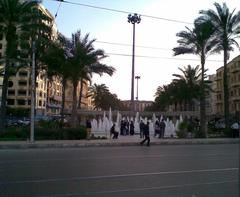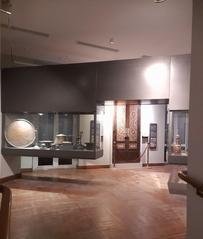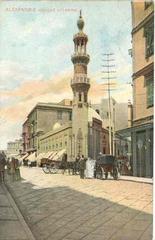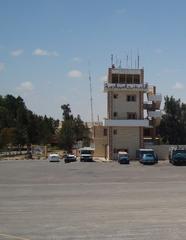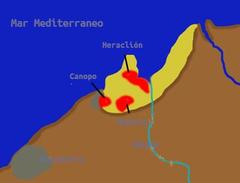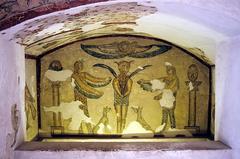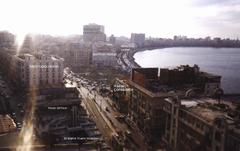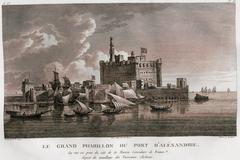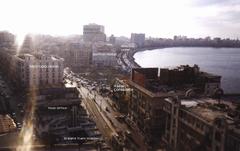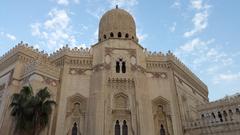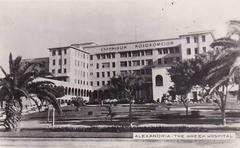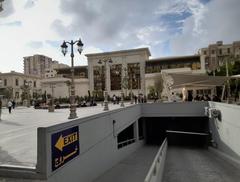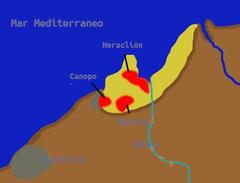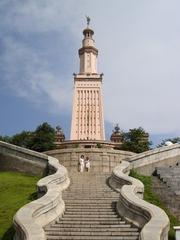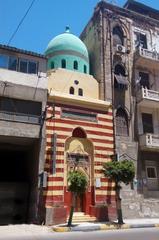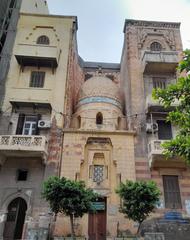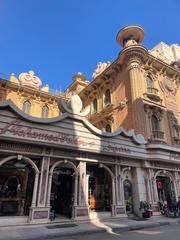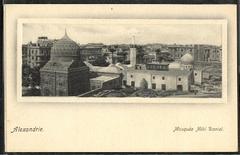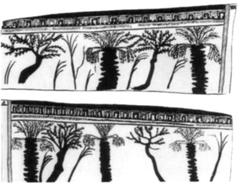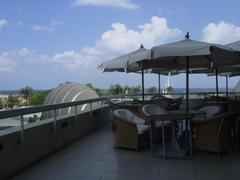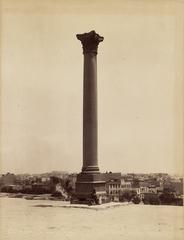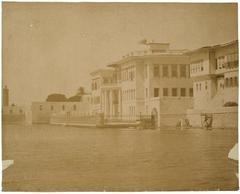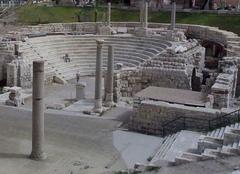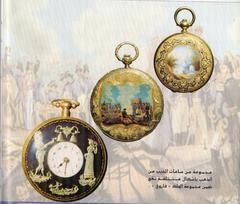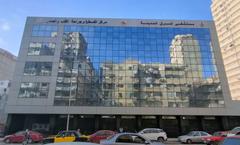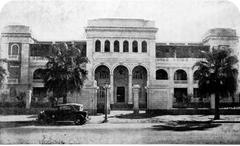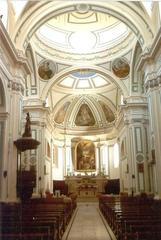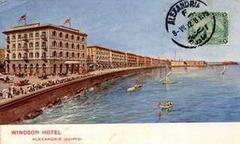Shatby Necropolis: Visiting Hours, Tickets, and Historical Significance in Alexandria, Egypt
Date: 14/06/2025
Introduction
Nestled in Alexandria, Egypt, the Shatby Necropolis stands as the city’s oldest known burial ground and a key testament to its Hellenistic heritage. Established shortly after Alexandria’s foundation by Alexander the Great in 331 BCE, this site offers a rare glimpse into early funerary practices, architectural innovation, and the vibrant, multicultural identity that defined ancient Alexandria. The necropolis preserves the memory of Macedonian settlers, Greeks, Egyptians, and other Mediterranean peoples, reflecting the syncretic spirit of the city’s formative centuries (Bryn Mawr Classical Review; archaeology.wiki).
This comprehensive guide explores Shatby Necropolis’s history, practical visitor information, cultural significance, and its role in ongoing archaeological research, while also providing travel tips and comparisons to similar sites worldwide.
Table of Contents
- Introduction
- Origins and Historical Context
- Visiting Shatby Necropolis: Practical Information
- Nearby Attractions and Travel Tips
- Cultural and Archaeological Significance
- Comparative Analysis with Similar Sites Worldwide
- Frequently Asked Questions (FAQ)
- Conclusion and Recommendations
- List of Reliable Sources and Further Reading
Origins and Historical Context
Foundation of Alexandria and the Emergence of Shatby
Alexandria, founded by Alexander the Great in 331 BCE, quickly became a cosmopolitan center where Greek, Egyptian, and other Mediterranean cultures converged. As the city expanded, organized burial grounds were established outside the city limits, adhering to both Greek and Egyptian traditions. The Shatby Necropolis, situated on the city’s eastern edge, became Alexandria’s earliest known cemetery and a vital part of its urban and spiritual landscape (Bryn Mawr Classical Review).
Chronology and Use
Archaeological research dates the primary use of Shatby Necropolis to the late 4th and 3rd centuries BCE. The site served Alexandria’s earliest generations, including Macedonian settlers, Greeks, and locals. Its operation was relatively brief, with evidence suggesting an abrupt closure—possibly due to a catastrophic event—rather than a gradual decline (Top Ten Egypt). The cemetery’s abandonment is marked by layers of construction debris found in some burial chambers.
Architectural Features and Burial Practices
Shatby Necropolis is notable for its diverse funerary architecture. The site consists of surface graves and elaborate underground chambers (hypogea) accessible via dromoi (passageways). Hypogeum A, the most prominent, features a central courtyard, barrel-vaulted burial chambers, loculi (wall niches), arcosolia (arched recesses), and sarcophagi often shaped like funerary couches (klinai). The tombs blend Greek, Egyptian, and early Roman decorative motifs, including painted murals, stucco reliefs, and symbolic designs that narrate beliefs about death and the afterlife (Top Ten Egypt).
Burial practices included both inhumation and cremation. Grave goods—pottery, jewelry, personal items, and Hadra-type hydriae—reflect the diverse traditions and social status of those interred. The necropolis thus serves as a microcosm of early Alexandrian society (Bryn Mawr Classical Review).
Visiting Shatby Necropolis: Practical Information
Visiting Hours
- Open: Saturday to Thursday, 9:00 AM – 5:00 PM
- Closed: Fridays and public holidays
- Last entry: 4:30 PM
Ticket Information
- General admission: 50–60 EGP for adults
- Discounts: Available for students and seniors
- Purchase: On-site or via official Alexandria tourism platforms
Accessibility
- Wheelchair access to key areas (ramps and guided assistance available)
- Some underground chambers may pose challenges due to stairs and uneven surfaces
- Comfortable footwear and a flashlight or smartphone light recommended
Guided Tours and Special Events
- Guided tours (English/Arabic) led by archaeologists and local experts
- Educational workshops and cultural festivals held periodically—check the visitor center or official website for schedules
- Advance booking recommended for tours
Photography and Visitor Experience
- Photography permitted; flash and tripods may be restricted to protect artifacts and murals
- Information Center on site with multimedia displays and up-to-date research
- Enhanced visitor pathways, lighting inside burial chambers, and outdoor auditorium for events
Nearby Attractions and Travel Tips
Nearby Historical Sites
- Catacombs of Kom El Shoqafa: Blending Egyptian, Greek, and Roman elements
- Graeco-Roman Museum: Featuring artifacts from Shatby and other sites
- Bibliotheca Alexandrina: Modern library with exhibitions on Alexandria’s history
Travel Tips
- Arrive early for cooler temperatures and fewer crowds
- Use public transit or taxis; limited parking nearby
- Combine visits with other Alexandrian sites for a comprehensive historical tour
- Bring water and dress for warm weather, especially in summer
Cultural and Archaeological Significance
Insights into Hellenistic Alexandria
The Shatby Necropolis embodies the multicultural and syncretic nature of early Alexandria. Its tombs, grave goods, and artistic features document the blending of Greek, Egyptian, and Mediterranean customs, offering insight into religious beliefs, social status, and family relations. The site stands as a foundational reference for understanding the evolution of funerary practices in the Hellenistic world (archaeology.wiki).
Ongoing Research and Preservation
Recent decades have seen extensive restoration under the Alexandrian Necropolis Project, led by the Archaeological Society of Alexandria, Egypt’s Ministry of Tourism and Antiquities, and international partners including the Cyprus Institute and the National & Kapodistrian University of Athens. Initiatives include excavation, structural reinforcement, waterproofing, cleaning, and digital documentation (such as 3D modeling), ensuring both public access and long-term preservation (alex.arch.uoa.gr; Cyprus Institute).
Comparative Analysis: Shatby Necropolis and Similar Sites Worldwide
Alexandrian Necropoleis
- Kom El Shoqafa: Later, more Romanized, and more elaborate than Shatby; features a unique blend of Egyptian, Greek, and Roman motifs (alexander-the-great.org; the-past.com).
- Anfushi: Shares Hellenistic features but is less monumental, highlighting Shatby’s prominence as the city’s foundational necropolis (egyptopia.com).
Mediterranean Funerary Sites
- Vergina (Aigai), Greece: Monumental tombs for royalty; Shatby catered to a broader social spectrum, reflecting Alexandria’s diversity (urbanitaet.badw.de).
- Tarquinia, Italy: Both sites use domestic architecture motifs, but Shatby’s Greek style and multicultural context are distinctive.
- Tuna el-Gebel, Egypt: Later necropolis blending Greek and Egyptian practices; Shatby predates this syncretism.
Unique Features
- Oldest necropolis in Alexandria, foundational for the city’s funerary evolution
- Early and influential use of Greek domestic architecture in burial design
- Early example of Alexandria’s role as a cultural crossroads (archaeology.wiki)
- Modern restoration and digital documentation as heritage preservation benchmarks (apaclabs.cyi.ac.cy)
Frequently Asked Questions (FAQ)
Q: What are the Shatby Necropolis visiting hours?
A: Saturday to Thursday, 9:00 AM – 5:00 PM; closed Fridays and public holidays.
Q: How much are tickets?
A: General admission is 50–60 EGP; discounts for students and seniors.
Q: Are guided tours available?
A: Yes, in English and Arabic; advance booking is recommended.
Q: Is the site wheelchair accessible?
A: Key areas are accessible, but some underground chambers may be difficult to navigate.
Q: Can I take photographs?
A: Photography is allowed; flash and tripods may be restricted.
Q: What nearby attractions can I visit?
A: Catacombs of Kom El Shoqafa, Graeco-Roman Museum, Bibliotheca Alexandrina.
Conclusion and Recommendations
The Shatby Necropolis is an essential destination for anyone interested in Alexandria’s early history, Hellenistic funerary architecture, and multicultural heritage. Its restored tombs, rich assemblage of grave goods, and immersive visitor amenities—ranging from informative tours to digital displays—make it a model for heritage tourism and preservation. With accessible visiting hours, affordable tickets, and enhanced infrastructure, the site offers a comfortable and educational experience for all.
For the best visit:
- Confirm current opening hours and ticket prices online.
- Book guided tours for deeper insights.
- Explore nearby historic sites for a comprehensive Alexandria experience.
- Use the Audiala app for up-to-date guides and interactive maps.
Ongoing research and conservation efforts ensure that Shatby Necropolis will remain a bridge between past and present, illuminating the lives and beliefs of Alexandria’s earliest inhabitants.
Reliable Sources and Further Reading
- Shatby Necropolis Visiting Hours, Tickets, and Historical Insights in Alexandria, 2024, Bryn Mawr Classical Review (Bryn Mawr Classical Review)
- Visiting Shatby Necropolis: Hours, Tickets, and Exploring Alexandria’s Ancient Burial Site, 2024, Top Ten Egypt (Top Ten Egypt)
- Visiting the Shatby Necropolis in Alexandria: Hours, Tickets, and History of Egypt’s Oldest Burial Site, 2025, Alexandrian Necropolis Project (alex.arch.uoa.gr)
- Visiting the Shatby Necropolis: Hours, Tickets, and Historical Insights at Alexandria’s Oldest Archaeological Site, 2023, Archaeology Wiki (archaeology.wiki)
- Digital Documentation and Research at Shatby Necropolis, 2024, Cyprus Institute (Cyprus Institute)
- Shatby Necropolis Resting Place of Alexandria’s First Greek Settlers, 2025, Greek Reporter (greekreporter.com)
- Alexandria Government Official Site - Shatby Necropolis, 2024 (alexandria.gov.eg)
For more travel tips, virtual tours, and updates on Alexandria’s historical sites, download the Audiala app and follow our social media channels.

